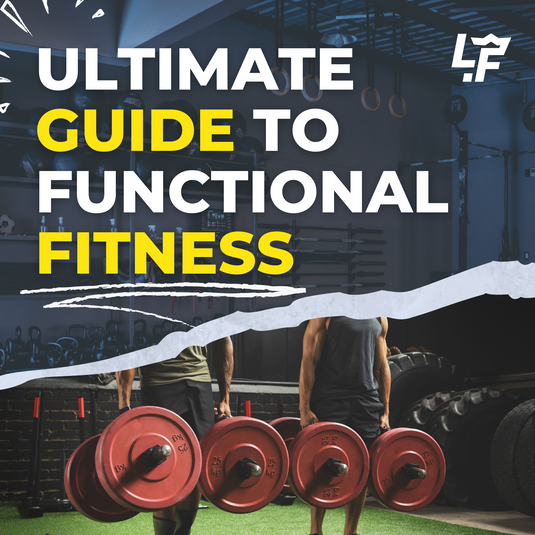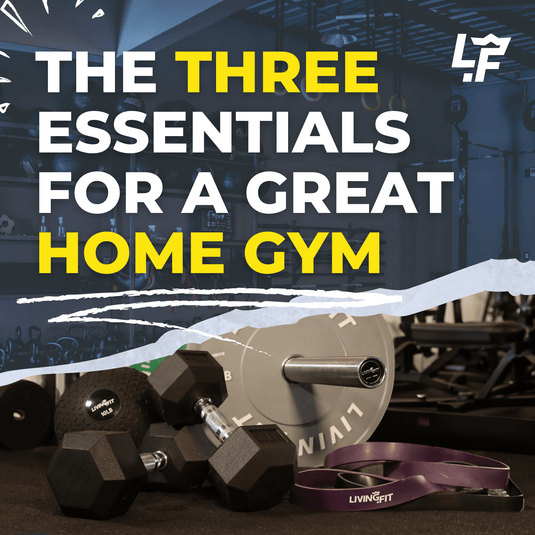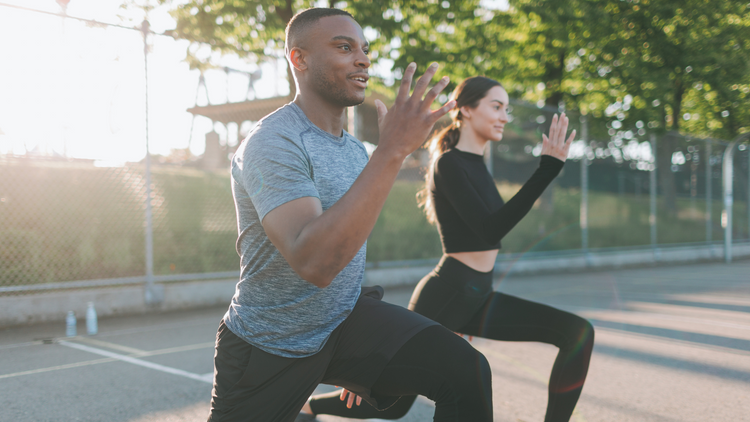7 Best Dumbbell Triceps Exercises to Build Sculpted Arms


Did you know that the triceps muscle makes up two-thirds of the size of your arm? That means how you train your triceps will determine how big or lean your arms look.If you've been trying to build bigger arms or get them lean and sculpted without success, your arm workouts miss something important: the right dumbbell tricep exercises.
Here's our list of the seven best dumbbell triceps exercises to build sculpted arms
Anatomy of the Triceps Muscle

The triceps brachii can be found on the back of the arm and has a characteristic "horseshoe" shape.
The name "triceps" refers to the three heads of the muscle, each with its point of origin. [1]
Long Head
Just below the shoulder joint socket, you'll find the origin point of the long head of the triceps. It originates from the infraglenoid tubercle of the scapula.
The long head is unique because it is the largest of the three heads and crosses over two joints, the shoulder and the elbow.
If it's the size you want, focus on long-head tricep exercises.
Medial Head
The medial head or middle part of the triceps muscle starts from the backside of your upper arm bone. It stretches from a groove near the middle of this bone to just above your elbow.

Lateral Head
The triceps muscle's lateral head or outer part also starts from your upper arm bone. The difference is that it comes from the back side, specifically from an area above the radial groove that runs along the middle of the bone.
Functions of the Triceps Muscle
The triceps muscle is responsible for several essential functions:
Extension of the Elbow
The primary function of the triceps is the extension of the elbow. When the triceps muscle contracts, it extends the elbow joint and straightens the arm.
Adduction of the Arm
The triceps also help to adduct the arm, bringing it down towards the body after it has been lifted away.
Stabilization of the Shoulder Joint
Remember how we said the long head was the largest and crossed over two joints? Because of this, the long head helps stabilize the shoulder joint, especially during arm movements. [2]
Why Choose Dumbbells for Triceps Training?
Why pick dumbbells out of all the exercise equipment you could choose to train your triceps?
Dumbbells are versatile, readily available, and offer several advantages that make them an excellent choice for triceps training.
Here are some of the benefits of dumbbell workouts
Unilateral Training
One of the key advantages of using dumbbells is that they allow for unilateral training, meaning you can work one arm at a time.
This is particularly important in preventing and correcting muscle imbalances, especially when working at home with dumbbells.
During a barbell exercise, the stronger side of your body could compensate for the weaker side. This is different with dumbbells, as using them would ensure equal effort.
Range of Motion
Dumbbells also enable a greater range of motion than other forms of weight training, especially during unilateral training. This can lead to more effective muscle stimulation and development.
Promoting Muscle Symmetry
Continuing with the points above, dumbbells can help ensure that both arms are worked equally, promoting better muscle symmetry by allowing each component to work independently. This is crucial not just for aesthetics but also for balanced strength and injury prevention.
The 7 Best Dumbbell Tricep Exercises
The exercises you use to target your triceps matter, but so does the order in which you do them.
We will kick off our list with compound exercises that target the triceps and allow you to go heavier than if you were performing an isolation exercise.
From here, we'll switch to isolation-focused movements that allow for a full range of motion and intense muscle contraction.
When you perform your dumbbell triceps workout, follow this order: overload the triceps with compound movements, then go for peak contraction with isolation exercises.
Here are our picks of the best dumbbell exercises for the triceps
1.) Dumbbell Floor Press
Limiting the range of motion, the floor press focuses directly on the triceps and chest muscles. It reduces strain on the shoulder joints, making it an excellent exercise for individuals with shoulder issues.
It's also safer since you can drop the dumbbells next to you without worrying about them rolling or bouncing.
Muscles Worked
- Pectoralis major
- Pectoralis minor
- Triceps brachii (all three heads)
How to Perform the Dumbbell Floor Press
- Place a set of dumbbells on the ground. Sit down, grab hold of the dumbbells, then lie back. Your knees should be bent and your feet flat on the floor.
- Bring the dumbbells to chest level, with your upper arms resting on the floor. Your arms should be perpendicular to the floor, and your palms should face your feet.
- Press the dumbbells upwards until your arms are fully extended. Focus on the contraction in the chest and triceps.
- Lower the dumbbells slowly back to the starting position and immediately go into the next repetition.
Progressions (How to Advance the Exercise)
Increase the Weight, Decrease Speed: If you're comfortable and can maintain perfect form, increase the weight you are using. Move slowly during the eccentric portion of the lift, counting to three seconds as you lower.
Common Mistakes and Tips for Proper Form
Flaring the Elbows: Some people tend to flare their elbows out to the sides during the press, which can strain your shoulder joints unnecessarily. Keep the elbows at a 45-degree angle.
Control the Weight: It's essential to control the movement rather than letting gravity do the work on the way down. Take it slow as you lower the weight and keep the muscles engaged.
Recommended Acute Variables
The more weight you use, the fewer the reps and the more sets you should perform.
- Endurance / Tone: 3-4 sets of 12-15 repetitions
- Strength: 3-4 sets of 6 to 8 repetitions
- Hypertrophy: 3-4 sets of 8 to 12 repetitions
2.) Close Grip Dumbbell Bench Press
Another compound exercise that incorporates the chest, the Close Grip Dumbbell Bench Press, brings the elbows tight to the body. This is going to demand much more from the triceps muscles.
Muscles Worked
- Triceps brachii (all three heads)
- Pectoralis major
How to Perform the Close Grip Dumbbell Bench Press
- Sit on a flat bench with a dumbbell in each hand and feet flat on the floor.
- Lay back, holding dumbbells near your chest. Your palms should be facing each other so the dumbbells are aligned.
- Push the dumbbells up, arms straight, and hands closer together than in a regular bench press. Squeeze your chest and triceps at the top.
- Slowly lower the dumbbells towards your chest, keeping elbows close to your body.
Progressions (How to Advance the Exercise)
Single-Arm Version: Perform this exercise with only one dumbbell. You'll need to slide more to one side of the bench to balance yourself.
Common Mistakes and Tips for Proper Form
Bouncing the Weight: Avoid bouncing the weight off your chest. Focus on controlling the weight the entire time.
Going Too Heavy: Start with a lighter weight and work up to a heavier weight.
Recommended Acute Variables
- Endurance / Tone: 3-4 sets of 12-15 repetitions
- Strength: 3-4 sets of 6 to 8 repetitions
- Hypertrophy: 3-4 sets of 8 to 12 repetitions
3.) Overhead Triceps Extensions
Our first isolation exercise, the Overhead Triceps Extension, allows you to go heavy and target the largest head of the triceps.
Muscles Worked
- Triceps brachii (long head)
How to Perform Overhead Triceps Extensions
- Stand up straight with a tight core. Hold a single dumbbell with both hands around the handle but move your fingers so they can grip the top of the dumbbell. The goal is a tight and firm grip.
- Lift the dumbbell over your head until both arms are fully extended. This is your starting position.
- Lower the dumbbell by keeping your upper arms close to your head and elbows in. You'll lower it in a semicircular motion behind your head until your forearms touch your biceps.
- Use your triceps to lift the dumbbell back to the starting position.
Progressions (How to Advance the Exercise)
Use Two Dumbbells: Try the same exercise but use two dumbbells. Press the dumbbells together as you move the weights.
Common Mistakes and Tips for Proper Form
Using Back or Shoulders: Some people use their back or shoulders to lift the weight, but this exercise should primarily engage the triceps.
Locking Out Elbows: Fully extending and locking out your elbows at the top can place unnecessary stress on your elbow joints.
Recommended Acute Variables
- Endurance / Tone: 3-4 sets of 12-15 repetitions
- Strength: 3-4 sets of 6 to 8 repetitions
- Hypertrophy: 3-4 sets of 8 to 12 repetitions
4.) Single-Arm Dumbbell Overhead Extension
The single-arm version of the overhead extension further isolates the triceps, ensuring each side is pulling its own weight.
Muscles Worked
- Triceps brachii (long head)
How to Perform the Single-Arm Dumbbell Overhead Extension
- Stand up straight, holding a dumbbell in one hand. Your feet should be about shoulder-width apart for balance.
- Extend the arm holding the dumbbell straight up towards the ceiling. This will be your starting position.
- Keeping your upper arm still and close to your ear, bend at the elbow to lower the dumbbell behind your head. You should feel a stretch in your triceps.
- Using your triceps, extend your arm back to the starting position. Make sure to keep your upper arm still throughout the movement.
Progressions (How to Advance the Exercise)
Perform the exercise on a Stability Ball or Bosu Ball: This adds the element of balance and stability, engaging your core and stabilizer muscles even more during the training.
Common Mistakes and Tips for Proper Form
Flaring the Elbow: Keep your elbow close to your head, and don't let it flare out.
Poor Posture: Ensure your core is engaged and your back is straight to maintain good form and balance.
Recommended Acute Variables
- Endurance / Tone: 2-3 sets of 15 repetitions
- Strength: 3 sets of 6 to 8 repetitions
- Hypertrophy: 2-3 sets of 8 to 12 repetitions
5.) Lying Triceps Extensions
Also known as "skull crushers," this exercise is unique because of the element of unilateral training with the dumbbells. Each tricep muscle must perform the same amount of work, which will help correct any potential muscle imbalance you have.
Muscles Worked
- Triceps brachii (medial and lateral heads)
How to Perform Lying Triceps Extensions
- Lie flat on a bench with your feet firmly planted on the ground. Hold a dumbbell in each hand and extend your arms above you so the dumbbells are over your chest. Your palms should be facing each other.
- With your upper arms locked, bend your elbows to lower the dumbbells toward your head. The dumbbells should come down on either side of your head, and you should feel a stretch in your triceps.
- Push the dumbbells to the starting position by extending your elbows and contracting your triceps.
- Keep your upper arms stationary and only move from the elbow joint.
Progressions (How to Advance the Exercise)
Shift the Weight: Alternate between workouts with the weight you use; aim for strength with more weight and fewer reps. At your next activity, use less weight and more reps. Focus on a full extension and deep stretch on the triceps.
Common Mistakes and Tips for Proper Form
Moving the Upper Arms: Keep your upper arms stationary. The movement should only be at the elbow joint, with your upper arms remaining still.
Using Momentum: Avoid using momentum to lift the weight. This reduces the effectiveness of the exercise and can lead to injury. It would be best if you controlled the movement throughout.
Recommended Acute Variables
- Endurance / Tone: 3-4 sets of 12-15 repetitions
- Strength: 3-4 sets of 6 to 8 repetitions
- Hypertrophy: 3-4 sets of 8 to 12 repetitions
6.) Standing Triceps Kickbacks
Standing triceps kickbacks are a classic isolation exercise that provides high intensity in the muscle while challenging core strength.
Muscles Worked
- Triceps brachii (lateral head)
How to Perform Standing Triceps Kickbacks
- Stand with your feet shoulder-width apart. Hold a dumbbell in each hand and keep your arms by your side.
- Bend your knees as you hinge at your waist, keeping your back straight. Your torso should be almost parallel to the floor.
- Start with your arms bent at a 90-degree angle so the dumbbells hang down towards the floor. Keeping your upper arms close to your body, extend your elbows and lift the dumbbells behind you until your arms are fully extended. Pause at the top and squeeze your triceps.
- Slowly bend your elbows to lower the dumbbells to the starting position.
Progressions (How to Advance the Exercise)
Use a Resistance Band: To increase the intensity of the exercise further, step on a resistance band and attach it to the other end of the dumbbell. The variable resistance from the band means there will be constant tension as you raise and lower the dumbbell.
Common Mistakes and Tips for Proper Form
Swinging the Dumbbells: Do not swing or use momentum. Move slowly and control the dumbbells every step of the way.
Poor Posture: Do not arch your back or let your upper body sink. Tighten your core and maintain a strong hinge at the hips.
Recommended Acute Variables
- Endurance / Tone: 3-4 sets of 15 repetitions
- Strength: 4 sets of 8 to 10 repetitions
- Hypertrophy: 3-4 sets of 8 to 12 repetitions
7.) Weighted Triceps Dips
Adding a dumbbell's weight to this bodyweight exercise can take your strength and muscle gains to the next level.
Muscles Worked
- Triceps brachii (all three heads)
How to Perform Weighted Triceps Dips
- Place a dumbbell on top of your thighs. The weight should be secure, and you should not risk falling once you're in motion.
- Sit at the edge of a bench or chair. Place your hands shoulder-width apart on the edge of the bench, fingers pointing forward. Put your legs in front of you flat on the floor.
- Bend your elbows and lower your butt toward the ground. Your elbows should bend to at least 90 degrees. Ensure your back is close to the bench during the descent.
- Push your body with your triceps until your arms are fully extended again. Avoid locking your elbows at the top of the movement.
Progressions (How to Advance the Exercise)
Superset with Another Triceps Exercise: This means performing another triceps exercise immediately after doing the overhead extension without rest in between.
Common Mistakes and Tips for Proper Form
Elbows Flare Out: Your elbows should remain close to your body throughout the movement.
Not Going Low Enough: Be sure to lower yourself to the point where your elbows are at a 90-degree angle.
Recommended Acute Variables
- Endurance / Tone: 3-4 sets of 15-20 repetitions
- Strength: 3-4 sets of 8 to 10 repetitions
- Hypertrophy: 3-4 sets of 8 to 15 repetitions
Go Beyond Your Triceps
Solid and sculpted triceps are one part of the bigger picture.
Ready to take your upper body workouts to the next level?
Take advantage of our comprehensive workout plan designed specifically for upper body development, featuring the best dumbbell exercises that will challenge and strengthen.
Check out our dumbbell upper body workout!
References
- Tiwana MS, Sinkler MA, Bordoni B. Anatomy, Shoulder and Upper Limb, Triceps Muscle. [Updated 2022 Aug 30]. In: StatPearls [Internet]. Treasure Island (FL): StatPearls Publishing; 2023 Jan-.
- Landin D, Thompson M, Jackson M. Functions of the Triceps Brachii in Humans: A Review. J Clin Med Res. 2018 Apr;10(4):290-293. doi: 10.14740/jocmr3340w. Epub 2018 Feb 18. PMID: 29511416; PMCID: PMC5827912.
Helpful Resources:
- Be alerted when we publish more like this to our blog here
- Daily workout plans here
- Fitness Equipment like dumbbells, resistance bands, etc here
- Free dumbbell workouts here
- Follow along with $1 video workouts here








